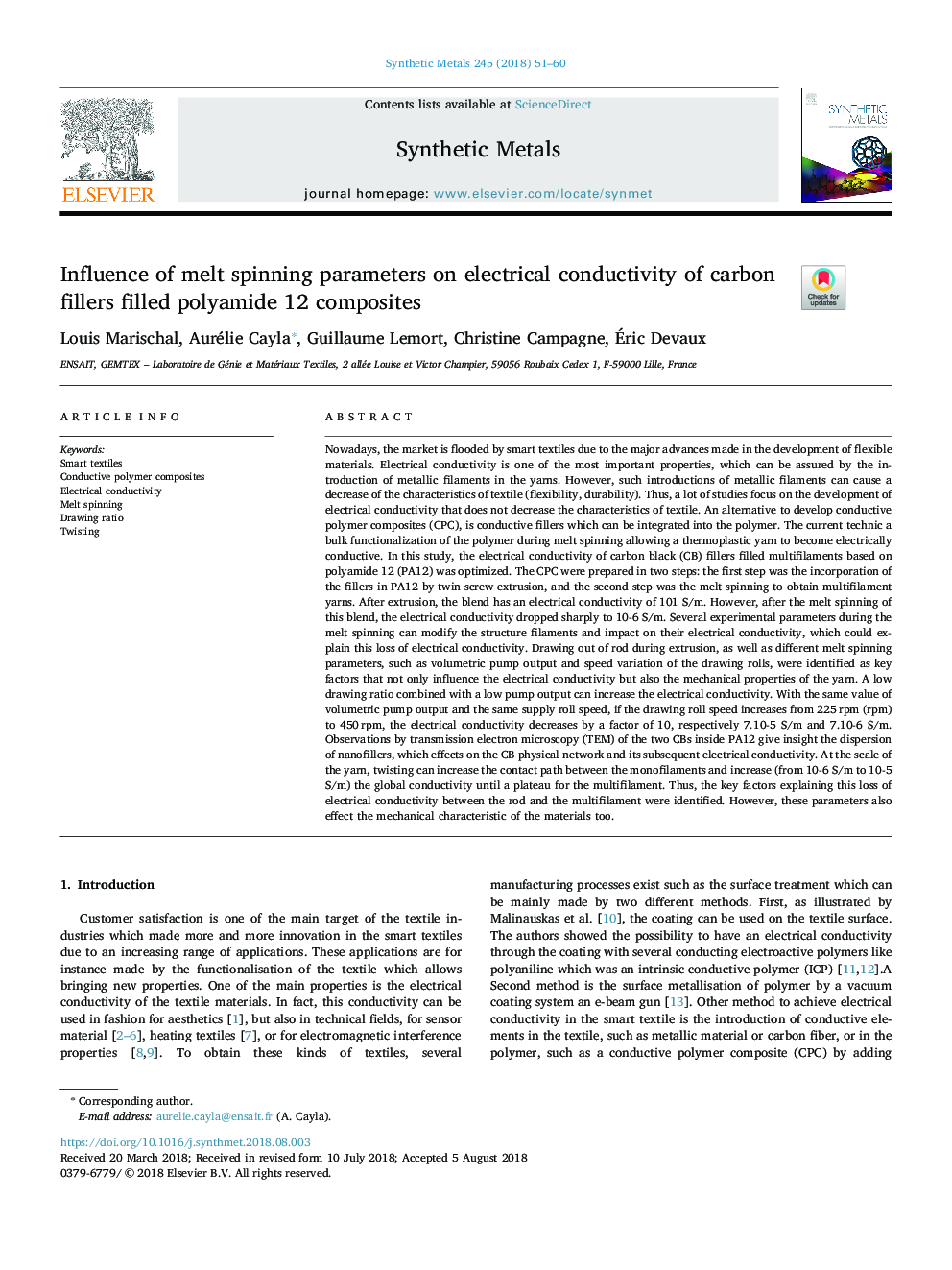| کد مقاله | کد نشریه | سال انتشار | مقاله انگلیسی | نسخه تمام متن |
|---|---|---|---|---|
| 9953488 | 1509333 | 2018 | 10 صفحه PDF | دانلود رایگان |
عنوان انگلیسی مقاله ISI
Influence of melt spinning parameters on electrical conductivity of carbon fillers filled polyamide 12 composites
ترجمه فارسی عنوان
تاثیر پارامترهای ریسندگی ذوب بر روی هدایت الکتریکی پرکننده های کربن پلی آمید 12 کامپوزیت
دانلود مقاله + سفارش ترجمه
دانلود مقاله ISI انگلیسی
رایگان برای ایرانیان
کلمات کلیدی
منسوجات هوشمند، کامپوزیت پلیمرهای هدایت پذیر، رسانایی الکتریکی، ذوب شدن، نسبت طراحی پیچش،
موضوعات مرتبط
مهندسی و علوم پایه
مهندسی مواد
بیومتریال
چکیده انگلیسی
Nowadays, the market is flooded by smart textiles due to the major advances made in the development of flexible materials. Electrical conductivity is one of the most important properties, which can be assured by the introduction of metallic filaments in the yarns. However, such introductions of metallic filaments can cause a decrease of the characteristics of textile (flexibility, durability). Thus, a lot of studies focus on the development of electrical conductivity that does not decrease the characteristics of textile. An alternative to develop conductive polymer composites (CPC), is conductive fillers which can be integrated into the polymer. The current technic a bulk functionalization of the polymer during melt spinning allowing a thermoplastic yarn to become electrically conductive. In this study, the electrical conductivity of carbon black (CB) fillers filled multifilaments based on polyamide 12 (PA12) was optimized. The CPC were prepared in two steps: the first step was the incorporation of the fillers in PA12 by twin screw extrusion, and the second step was the melt spinning to obtain multifilament yarns. After extrusion, the blend has an electrical conductivity of 101 S/m. However, after the melt spinning of this blend, the electrical conductivity dropped sharply to 10-6 S/m. Several experimental parameters during the melt spinning can modify the structure filaments and impact on their electrical conductivity, which could explain this loss of electrical conductivity. Drawing out of rod during extrusion, as well as different melt spinning parameters, such as volumetric pump output and speed variation of the drawing rolls, were identified as key factors that not only influence the electrical conductivity but also the mechanical properties of the yarn. A low drawing ratio combined with a low pump output can increase the electrical conductivity. With the same value of volumetric pump output and the same supply roll speed, if the drawing roll speed increases from 225ârpm (rpm) to 450ârpm, the electrical conductivity decreases by a factor of 10, respectively 7.10-5 S/m and 7.10-6 S/m. Observations by transmission electron microscopy (TEM) of the two CBs inside PA12 give insight the dispersion of nanofillers, which effects on the CB physical network and its subsequent electrical conductivity. At the scale of the yarn, twisting can increase the contact path between the monofilaments and increase (from 10-6 S/m to 10-5 S/m) the global conductivity until a plateau for the multifilament. Thus, the key factors explaining this loss of electrical conductivity between the rod and the multifilament were identified. However, these parameters also effect the mechanical characteristic of the materials too.
ناشر
Database: Elsevier - ScienceDirect (ساینس دایرکت)
Journal: Synthetic Metals - Volume 245, November 2018, Pages 51-60
Journal: Synthetic Metals - Volume 245, November 2018, Pages 51-60
نویسندگان
Louis Marischal, Aurélie Cayla, Guillaume Lemort, Christine Campagne, Ãric Devaux,
